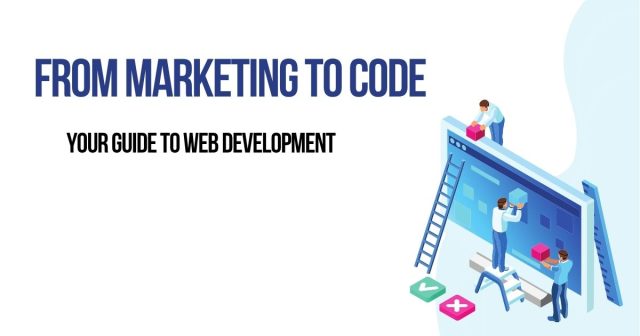Marketing professionals have always been tech-savvy problem solvers. You understand user behavior, analyze data, and create compelling digital experiences. These skills translate beautifully into web development—a field where creativity meets technical expertise.
Many marketers feel drawn to web development after working closely with developers on campaigns, landing pages, and website optimization. The transition might seem daunting, but your marketing background provides a solid foundation for coding success.
This guide will walk you through the essential steps to transition from inbound marketing to web development, highlighting the transferable skills you already possess and the technical knowledge you’ll need to acquire.
Why Marketing Experience Gives You an Edge

Your marketing background offers unique advantages in web development. You already understand user experience principles, conversion optimization, and how websites should function from a business perspective.
Marketers excel at understanding target audiences—a crucial skill in web development. When you build websites, you’re not just writing code; you’re creating user experiences that drive specific outcomes. Your ability to think about user journeys and conversion funnels makes you naturally suited to front-end development.
You’ve likely worked with content management systems, analytics tools, and marketing automation platforms. This technical exposure means you’re already comfortable with software interfaces and troubleshooting—essential skills for any developer.
Essential Web Development Skills to Learn
HTML and CSS Fundamentals
Start with HTML and CSS, the building blocks of web development. HTML structures content, while CSS handles styling and layout. These languages feel intuitive to marketers because they directly impact how users experience websites.
Focus on semantic HTML first. Learn to structure content logically using headings, paragraphs, lists, and forms. This knowledge builds on your content marketing experience, where you’ve organized information for readability and SEO.
CSS brings designs to life. You’ll learn to control colors, fonts, spacing, and layouts. Your eye for design, developed through creating marketing materials, will serve you well here.
JavaScript for Interactivity
JavaScript adds dynamic behavior to websites. It handles user interactions, form validations, and data manipulation. While more complex than HTML and CSS, JavaScript opens doors to advanced functionality.
Start with basic concepts like variables, functions, and event handling. Many marketing automation workflows you’ve created follow similar logical patterns—if this happens, then do that.
Responsive Design Principles
Your marketing experience taught you that mobile optimization matters. In web development, responsive design ensures websites work seamlessly across devices.
Learn CSS Grid and Flexbox for creating flexible layouts. Understand breakpoints and media queries to adapt designs for different screen sizes. This knowledge directly applies to creating mobile-friendly landing pages and email templates.
Building Your First Projects
Start with Simple Websites
Begin by recreating marketing pages you’ve worked on before. Build a simple landing page with a headline, benefits section, and call-to-action form. This familiar territory helps you practice coding while creating something useful.
Create a personal portfolio website showcasing your marketing projects. Include case studies, campaign results, and testimonials. This project serves double duty—you’ll practice web development while building a professional online presence.
Focus on Business-Relevant Projects
Build projects that solve real marketing problems. Create a simple lead capture form, design a pricing page, or develop a basic analytics dashboard. These projects demonstrate your unique value proposition as a marketer-turned-developer.
Consider rebuilding marketing tools you’ve used before. Create a simple campaign tracker, ROI calculator, or social media scheduler. These projects show you understand both the technical and business sides of web development.
Learning Resources and Timeline
Structured Learning Path
Dedicate 2-3 hours daily to learning web development. Start with free resources like freeCodeCamp, MDN Web Docs, and W3Schools. These platforms offer hands-on exercises and clear explanations.
Consider paid courses from platforms like Udemy, Coursera, or Codecademy for more structured learning. Look for courses that emphasize project-based learning over pure theory.
Practice Coding Daily
Consistency matters more than intensity. Code every day, even if only for 30 minutes. Use platforms like Codepen or JSFiddle to experiment with small code snippets.
Join coding communities like Stack Overflow, GitHub, and Reddit’s programming subreddits. These communities provide support, answer questions, and keep you motivated.
Timeline Expectations
Expect to spend 3-6 months learning fundamentals before feeling confident in your abilities. Your marketing background will accelerate certain aspects of learning, particularly user experience and design principles.
Plan for 6-12 months of consistent study to become job-ready. This timeline varies based on your learning pace and the complexity of the roles you’re targeting.
Leveraging Your Marketing Background
Highlight Your Unique Value
Your marketing experience sets you apart from other junior developers. You understand business objectives, user behavior, and conversion optimization. Emphasize these skills when networking or applying for positions.
Many companies need developers who can think beyond code. Your ability to understand marketing funnels, A/B testing, and user analytics makes you valuable for roles involving customer-facing applications.
Target Marketing-Adjacent Roles
Look for opportunities at marketing agencies, SaaS companies, or e-commerce businesses. These organizations value developers who understand marketing challenges and can build solutions accordingly.
Consider roles like front-end developer, marketing technologist, or growth engineer. These positions blend technical skills with marketing knowledge, playing to your strengths.
Advanced Skills to Consider
Backend Development
Once comfortable with front-end technologies, explore backend development. Learn a server-side language like Python, Node.js, or PHP. This knowledge enables you to build complete web applications, not just user interfaces.
Backend skills open doors to roles involving marketing automation, CRM integrations, and data analysis—all relevant to your marketing background.
Database Management

Understanding databases becomes crucial as you advance. Learn SQL for data querying and manipulation. Your experience with marketing analytics will make database concepts more intuitive.
Consider learning about specific database systems like MySQL, PostgreSQL, or MongoDB. These skills prove valuable when building applications that store and retrieve marketing data.
Your Next Steps Forward
Transitioning from inbound marketing to web development requires dedication but offers rewarding career opportunities. Your marketing background provides unique advantages that set you apart in the developer job market.
Start with HTML and CSS fundamentals, then gradually progress to JavaScript and more advanced concepts. Focus on building projects that solve real marketing problems, showcasing your unique perspective.
Remember that learning web development is a continuous journey. Technologies evolve rapidly, and staying current requires ongoing education. Your marketing experience with adapting to new tools and platforms will serve you well in this dynamic field.
Begin your coding journey today by choosing a learning resource and committing to daily practice. Your marketing skills, combined with web development expertise, will create new opportunities for career growth and professional satisfaction.







